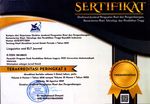Communicative Language Teaching Manifestation in an English as a Foreign Language Classroom
Abstract
Keywords
Full Text:
PDFReferences
A. W. Pratiwi, H. Atmowardoyo, and K. Salija, “The Use of Indonesian in Teaching English as the Foreign Language,” Journal of Art, Humanity, and Social Studies, vol. 2, no. 3, pp. 58–59, 2022, [Online]. Available: https://cutt.ly/yYJutbl
D. Nhem, “Journal of English Language Teaching Culture and ELT: Cambodian Teachers’ Perception and Practice of Textbook Adaptation to Realize Intercultural Awareness Article Info,” Journal of English Language Teaching, vol. 6, no. 1, pp. 65–67, 2017, [Online]. Available: http://journal.unnes.ac.id/sju/index.php/elt
T. T. H. Oanh and T. Q. Minh, “EFL Students’ Attitudes towards Integrating Teaching Cross-Cultural Issues and Teaching Listening Skill,” Studies in English Language Teaching, vol. 6, no. 2, p. 97, Mar. 2018, doi: 10.22158/selt.v6n2p97.
M. Maqsood et al., “Implications Of Online EFL Learning: An Empirical Study Of Language Use And Interaction In Teacher Education-Palarch’s,” Journal Of Archaeology Of Egypt/Egyptology, vol. 20, no. 2, pp. 1960–1980, 2023.
K. M. Al-Khamisi and Y. K. Sinha, “Communicative Language Teaching Methodologies in Omani EFL Context,” Open J Mod Linguist, vol. 12, no. 04, pp. 481–503, 2022, doi: 10.4236/ojml.2022.124035.
L. Wei, H.-H. Lin, and F. Litton, “Communicative Language Teaching (CLT) in EFL Context in Asia,” Asian Culture and History, vol. 10, no. 2, p. 1, Mar. 2018, doi: 10.5539/ach.v10n2p1.
W. A. Alamri, “Communicative Language Teaching: Possible Alternative Approaches to CLT and Teaching Contexts,” English Language Teaching, vol. 11, no. 10, p. 132, Sep. 2018, doi: 10.5539/elt.v11n10p132.
S. Nur, M. B. Sholeh, and K. Salija, “Task-Based Learning (TBL) in EFL Classroom: From Theory to Practice,” International Journal of Humanities and Innovation (IJHI, vol. 3, no. 4, pp. 138–143, 2020.
A. Noori, “Communicative Language Teaching (CLT) in EFL Context: Exploring Afghan EFL Lecturers’ Perceived Challenges in Implementing CLT,” International Journal of Research Available, vol. 05, no. 16, pp. 1050–1051, 2018, [Online]. Available: https://edupediapublications.org/journals
L. O. Nggawu and N. T. P. Thao, “The Impact of Communicative Language Teaching (CLT) Approach on Students’ Speaking Ability in a Public Indonesian University: Comparison between Introverts and Extrovert Groups,” International Journal of Language Education, vol. 7, no. 3, pp. 393–400, 2023, doi: 10.26858/ijole.v7i3.50617.
D. Dibekulu and D. D. Alem, “Teaching Grammar: In The View of Conventional VS Contemporary Approach,” An International Journal of English Language, vol. 10, no. 2, pp. 7–9, 2021, [Online]. Available: http://interactionsforum.com/
S. A. AL-Garni and A. H. Almuhammadi, “The Effect of Using Communicative Language Teaching Activities on EFL Students’ Speaking Skills at the University of Jeddah,” English Language Teaching, vol. 12, no. 6, p. 72, May 2019, doi: 10.5539/elt.v12n6p72.
N. Chathamkulam Abdulrahman and E. A. S. Abu-Ayyash, “Linguistic competence, Communicative Competence and Interactional Competence,” International Journal of Computers and Technology, vol. 19, pp. 7537–7552, Nov. 2019, doi: 10.24297/ijct.v19i0.8505.
T. Mao, “Investigation of L2/Ln Pragmatic Competence: Its Core and Route Map,” Front Psychol, vol. 12, pp. 1–10, Aug. 2021, doi: 10.3389/fpsyg.2021.690550.
L. Thi and N. Hien, “Journal of English Language Teaching and Applied Linguistics Communicative Language Teaching in Teaching ESL for University Students,” Journal of English Language Teaching and Applied Linguistics, vol. 3, no. 6, pp. 49–50, 2021, doi: 10.32996/jeltal.
M. M. Rahman, M. K. M. Singh, and A. Pandian, “Exploring ESL teacher beliefs and classroom practices of CLT: A case study,” International Journal of Instruction, vol. 11, no. 1, pp. 295–310, Jan. 2018, doi: 10.12973/iji.2018.11121a.
G. F. Daar and T. A. Ndorang, “Analysis the Implementation of Communicative Language Teaching and Classroom Interaction in the Effort to Increase Learners’ Speaking Skills,” International Journal for Educational and Vocational Studies, vol. 2, no. 12, pp. 969–970, Dec. 2020, doi: 10.29103/ijevs.v2i12.2969.
K. Kamelia, “Using Video as Media of Teaching in English Language Classroom: Expressing Congratulation and Hopes Article History,” Journal of Ultimate Research and Trends in Education, vol. 1, no. 1, pp. 34–38, 2019, [Online]. Available: http://ojs.journal.unilak.ac.id/index.php/utamax
L. T. Hang and V. H. Van, “Building Strong Teaching and Learning Strategies Through Teaching Innovations And Learners,” International Journal of Education and Practice, vol. 8, no. 3, pp. 498–510, 2020, doi: 10.18488/journal.61.2020.83.498.510.
M. D. Abdulrahaman et al., “Multimedia Tools in The Teaching and Learning Processes: A Systematic Review,” Heliyon, vol. 6, no. 11, pp. 2–6, Nov. 2020, doi: 10.1016/j.heliyon.2020.e05312.
L. O. Nggawu and N. T. P. Thao, “The impact of Communicative Language Teaching (CLT) Approach on Students’ Speaking Ability in a Public Indonesian University: Comparison between Introverts and Extrovert Groups,” International Journal of Language Education, vol. 7, no. 3, pp. 400–413, 2023, doi: 10.26858/ijole.v7i3.50617.
E. Reyes-Chua and M. Wacnag Lidawan, “European Journal of Foreign Language Teaching Games As Effective ESL Language Classroom Strategies: A Perspective From English Major Students,” European Journal of Foreign Language Teaching , vol. 4, no. 1, pp. 111–115, 2019, doi: 10.5281/zenodo.2621548.
T. N. Fitria, “Authentic Material and Created Material (Teacher-Made) for English Language Teaching (ELT): Benefits and Limitations,” Journal of Academia in English Educations, vol. 3, no. 2, pp. 117–140, 2022, doi: 10.32505/jades.v3i2/4674.
L. Thi and N. Hien, “Journal of English Language Teaching and Applied Linguistics Communicative Language Teaching in Teaching ESL for University Students,” Journal of English Language Teaching and Applied Linguistics, vol. 3, no. 6, pp. 50–55, 2021, doi: 10.32996/jeltal.
J. Ishaka Putra, L. Muh Halilurrahman, and S. Riadi Jaelani, “Enhancing English Language Proficiency: Strategies for Improving Student Skills,” Journal of Scientific Research, Education and Technology, vol. 2, no. 3, pp. 1118–1120, 2023.
Y. Shabaneh and M. Farrah, “The Effect Of Games On Vocabulary Retention,” Indonesian Journal of Learning and Instruction, vol. 2, no. 01, pp. 79–85, Mar. 2019, doi: 10.25134/ijli.v2i01.1687.
A. Jaiswal, T. Karabiyik, P. Thomas, and A. J. Magana, “Characterizing Team Orientations And Academic Performance in Cooperative Project-Based Learning Environments,” Educ Sci (Basel), vol. 11, no. 9, pp. 4–10, Sep. 2021, doi: 10.3390/educsci11090520.
I. Ramadhan, L. S. Nanda, P. R. Alfiona, and W. S. Nejed, “English Education Development Effort With A Communicative Language Teaching (CLT) Approach Method,” DIAJAR: Jurnal Pendidikan dan Pembelajaran, vol. 1, no. 1, pp. 106–115, Jan. 2022, doi: 10.54259/diajar.v1i1.236.
B. F. C. Nwokedi, “Influence of Classroom Environment on the Academic Performance of Students in English Language,” International Journal of Advance Social Sciences and Education (IJASSE), vol. 1, no. 4, pp. 191–198, Dec. 2023, doi: 10.59890/ijasse.v1i4.732.
J. Viktorin, “Teacher Assistant in the Inclusive School Environment,” The Educational Review, USA, vol. 2, no. 6, pp. 320–325, Jun. 2018, doi: 10.26855/er.2018.06.001.
K. Hayashi, T. Mochizuki, and Y. Yamauchi, “A Case Study Of Process Performances During A Small-Group Activity: Comparison Between A Round-Shaped And A Crescent-Shaped Seating Arrangements in Studio-Style Learning Spaces,” Learn Environ Res, vol. 26, no. 2, pp. 401–425, Jul. 2023, doi: 10.1007/s10984-022-09436-8.
A. O. Alharbi, “Issues with Communicative Language Teaching Implementation in Saudi Arabia Concerning the Government Policy, Teachers, and Students: Two Decades of Research,” Arab World English Journal, vol. 13, no. 2, pp. 412–423, Jun. 2022, doi: 10.24093/awej/vol13no2.28.
A. Amik, B. Bogor, J. Raya, and M. N. 168 Bogor, “Improving Students’ Speaking Skill Through CLT An Action Research,” Wanastra, vol. X, no. 1, pp. 17–21, 2018.
P. Murti and B. Jabu, “Students’ English Speaking Difficulties and Teachers’ Strategies in English Teaching: A Case Study at SMA 10 Gowa,” PERFORMANCE: Journal of English Education and Literature, vol. 1, no. 1, pp. 50–63, 2022.
DOI: https://doi.org/10.31764/leltj.v12i1.24103
Refbacks
- There are currently no refbacks.
Copyright (c) 2024 Dian Novita

This work is licensed under a Creative Commons Attribution-ShareAlike 4.0 International License.
_____________________________________________________
Linguistics and ELT Journal
p-ISSN 2339-2940 | e-ISSN 2614-8633

LELTJ is licensed under a Creative Commons Attribution-ShareAlike 4.0 International License.
_____________________________________________________
LELTJ is abstracting & indexing in the following databases:
_____________________________________________________
LELTJ Editorial Office:













